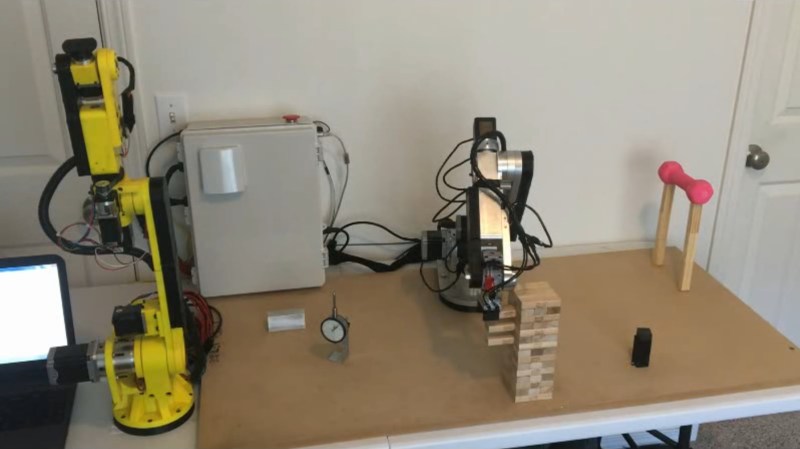We’ve seen industrial robotic arms in real life. We’ve seen them in classrooms and factories. Before today, we’ve never mistaken a homemade robotic arm for one of the price-of-a-new-home robotic arms. Today, [Chris Annin] made us look twice when we watched the video of his six-axis robotic arm. Most of the DIY arms have a personal flare from their creator so we have to assume [Chris Annin] is either a robot himself or he intended to build a very clean-looking arm when he started.
He puts it through its paces in the video, available after the break, by starting with some stretches, weight-lifting, then following it up and a game of Jenga. After a hard day, we see the arm helping in the kitchen and even cracking open a cold one. At the ten-minute mark, [Chris Annin] walks us through the major components and talks about where to find many, many more details about the arm.
Many of the robotic arms on Hackaday are here by virtue of resourcefulness, creativity or unusual implementation but this one is here because of its similarity to the big boys.
Thank you, [Juan Pablo Kutianski] for the tip!















Nice. I’m waiting for the day one of you sets up a mini-factory at your house.
A parts kit would be awesome. I’d probably buy one.
One suggestion: add on something like the Mechaduino (open-source servo controller and position sensor that turns a standard stepper motor into an industrial servo) for accurate torque-sensing and feedback, perhaps even allowing interactive tactile programming of the robot.
https://hackaday.io/project/11224-mechaduino
Here’s a higher power version of the Mechaduino:
https://hackaday.io/project/27823-highpower-mechaduino
I was going to comment on how slow it looks, until I saw the demo where he held a tomato while the robot cut it with a very sharp knife. Gave me the heebie-jeebies.
The tradeoff between speed and strength is hard to overcome, and it looks like the arm is very strong.
I thought most industrial robots use servos. Wouldn’t those be stronger and more accurate?
The primary factor influencing arm performance are the gearboxes. You need a very expensive combination of features: the gearboxes must have zero backlash (play), be incredibly rigid, and provide very high reduction ratios.
Doing this properly is nearly impossible for a hobbyist, since zero-backlash planetary/harmonic/cycloidal reducers run 4-5 figures per axis.
Hobby arms always fall back to timing belts or cheap gearboxes which limits their usefulness. Even a very high quality planetary reducer might have 0.2 degrees of play, and over a 50cm long lever that becomes almost 2mm of position uncertainty.
Some Industrial arms will repeat to <0.02mm under load.
That makes me wonder why we rarely (never?) see the encoders from old inkjet printers used with motor drives. Or to be low cost and very accurate, PCB circles laid out like Inductosyn encoders. I have a cheap protractor from China that uses them and reads out to hundredths of a degree or better.
I work around industrial arms regularly. They don’t have a lot of (any) wires hanging off of motors…
and?
And there is no way that this arm could be mistaken for a commercial arm. No way.
Where do they route the wires then? Inside the arms? IMO, the featured arm has a great wire layout for a hobby project.
Put batteries in the arms and use wifi or a one-wire with the arm as ground.
A robot arm should be reliable, from some strength on this is even a safety issue. So any wireless control link is to be ruled out imo. And it should be durable, so there is no justification to use several batteries for fixed arm.
Or is your comment a joke?
For sure the wires can be bundled to harnesses and protected by some tubing. Of course hollow mechanicla components would be an option, but are more effort in manufacturing.
I’m sure it’s not hard to cook up a DIY dress-pack if the application requires it. Clearly that hasn’t been needed yet.
I imagine for the obsessive-compulsive that like to neat their PC wiring.
This is hackaday bro. Look at the skill…tidying wires is simple.
It’s still in development and testing, getting taken apart from time to time. That wiring is just fine. Quality of all the work looks high-end. Will be laced up easily and nice as the final step.
+5 on the impressive skill! Would say quality hacking but this work is a step above just hacking.
You miss my point. This arm is not what industrial arms look like at all. I am commenting on the appearance of the arm, not the skill required to build it or tidy it up.
What’s the accuracy?
The video says repeatability “close to 30 thousands”.
Wow, very very impressive. What a work has gone into this.
I will certainly dive into your manual. It looks very strong and seems to be precise enough for me.
Great job and thank you for sharing.